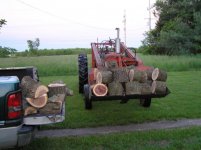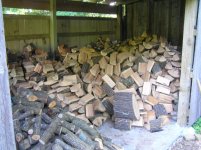I'm making a kinetic log splitter using 5 Chevy 235 flywheels spinning on a 1" shaft. The motor is an Army surplus 2-cyl 9 h.p. motor. There is a pinion gear on the shaft that drives a rack that pushes a sled 26" down a 6" wide H-beam. The sled is 6" X 6" and weighs about 10 pounds. I'd like to lessen the drag on the sled so was thinking of fastening two strips of low-friction materal to the bottom of the sled. Does anyone have a suggestion what I could use? I thought about ball bearings but the design of the sled rules out ball bearings. The sled and H beam are both mild steel. At one time I thought of linear slides but I don't know if they are stout enough.
How to install the app on iOS
Follow along with the video below to see how to install our site as a web app on your home screen.
Note: This feature may not be available in some browsers.
You are using an out of date browser. It may not display this or other websites correctly.
You should upgrade or use an alternative browser.
You should upgrade or use an alternative browser.
Need 2 Strips of Low Friction Material
- Thread starter Robere210
- Start date
- Replies 93
- Views 6,228
true temper
Stainless
- Joined
- Jun 19, 2006
- Location
- Kansas
Hold my beer someone’s fixing to get hurt.
Limy Sami
Diamond
- Joined
- Jan 7, 2007
- Location
- Norfolk, UK
UHMWPE (aka poor boys PTFE) slippery as snot and cheap as chips
Plastic WTF I hear you scream, - once ''bedded in'' is very abrasion resistant, ..ever tried grinding PE ?
WTF I hear you scream, - once ''bedded in'' is very abrasion resistant, ..ever tried grinding PE ?
Oh and don't make the clearances too tight - remember it's a log splitter.
Plastic
 WTF I hear you scream, - once ''bedded in'' is very abrasion resistant, ..ever tried grinding PE ?
WTF I hear you scream, - once ''bedded in'' is very abrasion resistant, ..ever tried grinding PE ?Oh and don't make the clearances too tight - remember it's a log splitter.
Scruffy887
Titanium
- Joined
- Dec 17, 2012
- Location
- Se Ma USA
ChipSplitter
Titanium
- Joined
- May 23, 2019
- Location
- Maybe
What are you guys bitching about? It can only kill him once......
Limy Sami
Diamond
- Joined
- Jan 7, 2007
- Location
- Norfolk, UK
Scruffy me ole china, that link doesn't load 

Scottl
Diamond
- Joined
- Nov 3, 2013
- Location
- Eastern Massachusetts, USA
Most of the major woodworking suppliers carry slick strips, thin strips of UHMW Poly with a self adhesive backing. They are meant for facing rip fences, etc.
Easy to replace when worn.
Easy to replace when worn.
CAMasochism
Stainless
- Joined
- Jun 6, 2019
- Location
- DFW, Texas
What are you guys bitching about? It can only kill him once......
Not if he winds up half dead from the first time.
crossthread
Titanium
- Joined
- Aug 5, 2004
- Location
- Richmond,VA,USA
I have built four or five log splitters in my time and I think you might be over thinking this. If you are going to add slick strips then I agree UHMW would be a good choice. However if this splitter has any ass to it at all then I don't think the strips are needed. Just grease up the sled. Greased steel on steel seems to me like it would be more then adequate.
TeachMePlease
Diamond
- Joined
- Feb 11, 2014
- Location
- FL
Here is a vid with a flywheel. First spliter looks sorta safe, second one could go very wrong.
YouTube
Holy crap, that second one is scary for a multitude of reasons.
Robere210 said:Here's the one I'm copying.
Complete with unprotected dog trying to bite an unprotected drive belt?
Maybe I'm overly cautious.... But dang.
michiganbuck
Diamond
- Joined
- Jun 28, 2012
- Location
- Mt Clemens, Michigan 48035
Warring to be written on a splitter.... load holding logs by Sides - Not Ends
One of our Boy Scouts loading wrong had the ram smash his hand.
You could put a hinge on the table so the log once past the blade world slide forward to pile the stack in front.
Hinge table up position in up position when you wish to choose where to stack.
One of our Boy Scouts loading wrong had the ram smash his hand.
You could put a hinge on the table so the log once past the blade world slide forward to pile the stack in front.
Hinge table up position in up position when you wish to choose where to stack.
ChipSplitter
Titanium
- Joined
- May 23, 2019
- Location
- Maybe
Just do this: rent a firewood processor - Google Search
Ray Behner
Diamond
- Joined
- Mar 27, 2009
- Location
- Brunswick Oh USA
What's to like? Where's the advantage? If you can't afford hydraulics, save your money until you can. I can only imagine what can go wrong. At least with hyd. you can stop the son-of- bitch. How about the big piece of shit that "rubber shoes" was running. 'bout broke his leg. No time to think or move. Did anyone happen to notice they all were splitting nice soft straight grain low BTU garbage. Try it on some real wood! The safest one ever built will still be a scary bastard waiting to unleash it's terror. Too damn scary for me.
Ray, the advantage is speed. With the splitter I'm making the activator handle must be held up for the pinion gear to engage the rack. Plus I have 20 acres of hardwood. I pick trees that aren't a jumble of crotches. When I run into a crotch I noodle it with my chainsaw.
By the way take a look at this impossible limb on one of my trees:

This is on a tree that leaned over some years back. I didn't notice it until I'd cut almost up to it. I'm going to leave it like that.
Sorry about the punctuation. The comma doesn't work on this keyboard. New one on the way.
By the way take a look at this impossible limb on one of my trees:

This is on a tree that leaned over some years back. I didn't notice it until I'd cut almost up to it. I'm going to leave it like that.
Sorry about the punctuation. The comma doesn't work on this keyboard. New one on the way.
Last edited:
bhigdog
Stainless
- Joined
- Jul 20, 2005
- Location
- Eastern PA
Ray, the advantage is speed.
Yeah, I hate getting maimed slowly. Get it over with as fast as you can........Bob
Yeah, I hate getting maimed slowly. Get it over with as fast as you can........Bob
howieranger
Aluminum
- Joined
- Jan 24, 2007
- Location
- Mountain Home AR.
I have heated with wood for over 40 years and have split hundreds of cords and speed was not a consideration as a tradeoff to safety. Hydraulic splitters ar slower for a reason and with the momentum needed to split red oak is allot different than softwood especially when you hit a knot. I think few people have the reaction time to operate one of those safely. Ray hit the other points on the head.
ChipSplitter
Titanium
- Joined
- May 23, 2019
- Location
- Maybe
If you have a death wish, we can't help you......

Similar threads
- Replies
- 8
- Views
- 1K
- Replies
- 0
- Views
- 640



